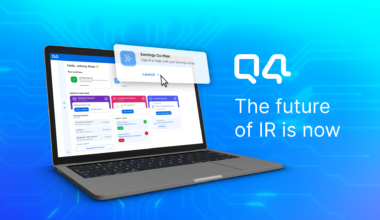Creating content to clearly communicate key messages to investors has long been an important element of an effective investor relations strategy. But, the value of that content doesn’t end once it has been posted or distributed. Understanding how Wall Street engages with your investor relations content can be a powerful tool for more effective communication, improved targeting, identifying trends, and guiding the allocation of resources toward the most impactful IR efforts.
Billy Eckert, head of surveillance and intelligence at Q4, highlights the importance of content and its role in engaging investors, analysts, and other shareholders, “Knowing who is engaging with your IR content can provide a much more clear and valuable picture of your audience. It gives you a better idea of who is sitting across the table and can uncover added insights into not only their level of knowledge, but often a bit about their focus and intention.”
Further, understanding not only “who” but “what” content investors are focused on can provide invaluable information. “Having intelligence into who is engaging with what content allows an IRO to size up what’s resonating with the Street and what’s not. Knowing which themes garner attention and which drive additional questions can help an IRO understand when more clarity is needed,” adds Eckert.
For instance, if an annual report had more downloads than last year’s, ascertaining what changed might point to themes that are resonating better with investors.
Start with web analytics
A good place to start is with web analytics. Most IROs already have access to Google Analytics, which allows for ongoing monitoring of the website to collect intelligence around how visitors are interacting with what content. These reports indicate which pages are seeing the highest engagement and when, helping to determine what other factors might be contributing to changing levels of engagement.
Additionally, data indicating the amount of traffic and time spent reviewing specific pieces of content on the website can begin to tell an important and useful story about existing and potential investors – and what is most important to them.
Synthesizing multiple data points to better understand investors and prospects
While extremely useful, website analytics isn’t the only data point accessible to IROs. The key to truly leveraging the growing amount of data accessible to today’s IRO is the ability to bring it all together and create a more complete picture of your investor base. We call this Holistic Market Intelligence, which means compiling and synthesizing multiple data points across various sources, including website analytics, capital market intelligence, webcast or conference call data, NDR and conference participants, DTC settlement information, and CRM tools.
Linking web analytics with these additional data points, as well as what an analyst is observing around capital flow activity, can empower IROs with a unique and comprehensive view of their investors and prospects. Ultimately, layering disparate data points and then linking them to the IRO’s regular workflow can help paint the most accurate picture available.
Identifying risks or opportunities
“Once collected and synthesized, this data can help arm IROs with knowledge by providing more context around who is engaging with what information, helping to inform important decisions,” says Billy.
Having an increased understanding of what content investors are engaging with can help to guide strategy and tactics, both in preparing for potential shareholder shifts and other risks, and in identifying opportunities to engage with investors.
One valuable and actionable use for analytics and other data points is tracking potential activists. While not necessarily a perfect methodology, tapping into this information can alert IR and management to activists preparing to accumulate a position and allow them to formulate a plan in advance.
“For instance, a hedge fund manager spending significant time viewing your proxy statements and corporate governance pages could be an activist looking to shake up the company. This intelligence could alert the IRO to someone potentially looking to identify points to use as ammunition for campaigns down the line and provide an opportunity to get ahead of the situation,” explains Billy.
Alternatively, if there are high-quality investors hitting specific pages of the site, this might be a good time to discuss what kind of contact the company has had and whether it might be an opportune moment to reach out or increase engagement.
Optimizing results through a holistic approach
More and more, IR is seen as a sales function, where the IRO is managing a pipeline of investors. Having a holistic view of how investors are engaging with the company and available content can help IROs fill the investor pipeline and drive things through that funnel.
Combining multiple data points garnered from investor engagement with IR content can provide a bit more certainty around the quality of investors and where to allocate IR resources – and management’s time – most effectively. Having access to this knowledge also informs the IRO of what’s happening in the markets and shareholder side of the business, helping them do their job better and secure their seat at the table.
Learn how Electronic Arts is leveraging data to gather additional insights on their investor base by reading their case study.


